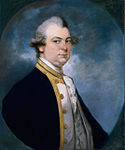Constantine Phipps, 2. Baron Mulgrave

Constantine John Phipps, 2. Baron Mulgrave (* 19. Mai 1744; † 10. Oktober 1792 in Lüttich) war ein britischer Entdeckungsreisender und Politiker.
Leben

Er war der älteste Sohn des Constantine Phipps, 1. Baron Mulgrave, aus dessen Ehe mit Hon. Lepell Hervey, Tochter des John Hervey, 2. Baron Hervey.
Phipps besuchte zunächst zusammen mit Joseph Banks das Eton College, verließ dieses aber frühzeitig und fuhr mit seinem Onkel, dem späteren Vice-Admiral Augustus Hervey, 3. Earl of Bristol, zur See. Bei der Royal Navy wurde er 1762 zum Lieutenant und 1765 Post-Captain befördert. 1766 reiste er zusammen mit Banks, der ihn als Naturforscher begleitete, nach Neufundland.
Am 4. Juni 1773 startete Phipps eine Fahrt zum geografischen Nordpol. Er hatte zwei Schiffe, die Racehorse und die Carcass. Zu seiner Mannschaft gehörte auch der junge Horatio Nelson. Nachdem sie Spitzbergen passiert hatten, wurden sie von den Eismassen zurückgedrängt und entschieden sich nach Erreichen von 80° 48' nördlicher Breite für die Heimreise. Nach dieser Fahrt beschrieb Phipps als erster Europäer den Eisbären und die Elfenbeinmöwe. Er stellte meteorologische und geologische Beobachtungen an, testete Bouguers Patentlog und versuchte, die Tiefe des Eismeers auszuloten.[1] 1774 veröffentlichte er diese Studien in einem Reisebericht.
In der Zeit von 1768 bis 1790 war Phipps mit einigen Unterbrechungen für verschiedene Wahlkreise Mitglied des britischen House of Commons. 1775 erbte er von seinem Vater den Titel eines Baron Mulgrave, der zur Peerage of Ireland gehörte und mit einem Sitz im irischen House of Lords verbunden war. 1790 wurde Phipps aufgrund seiner Verdienste auch in der Peerage of Great Britain zum Baron Mulgrave erhoben, wodurch er auch einen Sitz im britischen House of Lords erhielt und aus dem britischen House of Commons ausschied. Er verließ 1791 den öffentlichen Dienst und starb am 10. Oktober 1792 in Lüttich.
Während der britische Titel mit seinem Tod erlosch, da er keinen männlichen Abkömmling hatte, erbte sein Bruder Henry Phipps die irische Baronie.
Die Insel Phippsøya, eine der Sjuøyane („Sieben Inseln“) im Spitzbergen-Archipel ist heute nach ihm benannt.[2]
Schriften
- A Voyage towards the North Pole undertaken by His Majesty’s Command 1773, J. Nourse, London 1774. (englisch)
Literatur und Weblinks
- Ann Savours: “A very interesting point in geography”: The 1773 Phipps Expedition towards the North Pole (PDF; 9,0 MB). In: Arctic 37(4), 1984, S. 402–428 (englisch)
- Constantine John Phipps, 2nd Baron Mulgrave of New Ross auf thepeerage.com
Einzelnachweise
- ↑ H. H. Houben: Der Ruf des Nordens, Wegweiser-Verlag, Berlin 1927, S. 57–61.
- ↑ Phippsøya. In: The Place Names of Svalbard (Erstausgabe 1942). Norsk Polarinstitutt, Oslo 2001, ISBN 82-90307-82-9 (englisch, norwegisch).
| Vorgänger | Amt | Nachfolger |
|---|---|---|
| Constantine Phipps | Baron Mulgrave (Ireland) 1775–1792 | Henry Phipps |
| Titel neu geschaffen | Baron Mulgrave (Great Britain) 1790–1792 | Titel erloschen |
| Personendaten | |
|---|---|
| NAME | Phipps, Constantine, 2. Baron Mulgrave |
| ALTERNATIVNAMEN | Mulgrave, Constantine Phipps, 2. Baron |
| KURZBESCHREIBUNG | englischer Entdeckungsreisender |
| GEBURTSDATUM | 19. Mai 1744 |
| STERBEDATUM | 10. Oktober 1792 |
| STERBEORT | Lüttich |
Auf dieser Seite verwendete Medien
Autor/Urheber: Internet Archive Book Images, Lizenz: No restrictions
Identifier: voyagetowardsnor00mulg (find matches)
Title: A voyage towards the North Pole : undertaken by His Majesty's command, 1773
Year: 1774 (1770s)
Authors: Mulgrave, Constantine John Phipps, Baron, 1744-1792 Phipps, Constantine John, 1744-1792
Subjects: Racehorse (Ship)
Publisher: London : Printed by W. Bowyer and J. Nichols for J. Nourse
Contributing Library: MBLWHOI Library
Digitizing Sponsor: MBLWHOI Library
View Book Page: Book Viewer
About This Book: Catalog Entry
View All Images: All Images From Book
Click here to view book online to see this illustration in context in a browseable online version of this book.
Text Appearing Before Image:
to proceed from the fmailer pieces being thrownup by the force of the fea on the folid part. During thetime that we were fall amongft the Seven Iflands, we hadfrequent opportunities of obferving the irrefiftible force ofthe large bodies of floating ice. We have often feen apiece of feveral acres fquare lifted up between two muchlarger pieces, and as it were becoming one with them;and afterwards this piece fo formed afting in the famemanner upon a fecond and third; which would probablyhave continued to be the effeQ, till the whole bay hadbeen fo filled with ice that the different pieces could havehad no motion, had not the ftream taken an unexpededturn, and fet the ice out of the bay. 19th. Weighed in the morning with the wind atN N E. Before we got out of the bay it fell calm. I ob-ferved for thefe three or four days, about eleven in theevening, an appearance of dulk. 20th. of FAIR HAVEIS^, t/jclSLAyj) S (/(//t/(Y//r, (W tlie n brffj West Coaft S PITSBERGElSr an actual Survey taken d
Text Appearing After Image:
JSXP Z, A 2f A. T J O Hr. TheFiijnns xhorntv Dr/f/i ofntrfrrui I-iiriniz/s. T/t-jthirfs jfur/ATif itTrlt X r/n- Jtr/t-n/x .i Auriiiiiiiif/i/iTies — W/irirfiif Kineiicrsi-.a/n/Ilimi/s iJ/iilipntf/icdti/^s mrannexed.\./.s/irjidirberrlhi-ofseiiOPvnstmavrcin/iiliimwen-//latfe>i//i/lv_LatiiudeNjfl.so.ZomfitinieE lo:tn:-^o.Al/iice iibere &e olsenativHS (in tbeJiHiMum Nfn- /Jhnfe rh A7b/t/sl ^ZutitU(le),^j_g°: 44.Loni;ifrrdi-rinr<nnris niiir/ced7nti)fi?/,iffffffers/nj^eef:tnienjh>m tiie/s/i!nd\ . Jl;Sil.lj;; a. ippi. ■• JV- y-5- „. &(,s- P. 12^9,. f.!\OU. /■.i80(). o. iCjo. (■. ;521. //44<J. /, 711. /;. 1041. d. 2 10. //.liol. Di.Agi. I lij^Mui-pfc?^ ■MinffiimmnminniimMin sca/e t^Miles Oh to tfDi^/rfc. J I .dufer^/u- iMui. _ J^ 4^ f 7/^ tM C^&^t^ftil a/c44.4Cn,^ JOURNAL. „3 20th. At midnight, being exadly in the latitude of Aupuft.Cloven C
Note About Images

